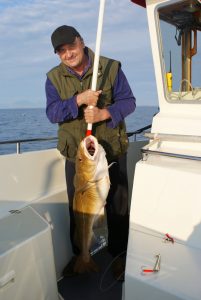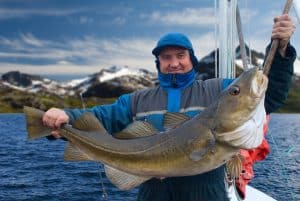Gaff fishing is a sport that has been around for many years. It originated in England and was originally used by people to catch large fish.
Today it’s considered a recreational activity, but it can still be used to catch big fish for example from charter boats if you know what you’re doing! In this article we will discuss what gaffs are, how to use them properly and even some tips for catching bigger gamefish!

The origins of gaff hooks
The history of fishing gaffs can be traced back to the English, who used it as a fishing tool in rivers and estuaries. They would use large hooks that had an attached pole on one end so they could hook fish from under the water without having to wade into the river or sea itself.
The first reference found for this type of fishing came from 16th century England where gaffs were considered “proper tackle” for catching huge carp and pike.
A gaffe (or “gaffer”) is any device used to catch fish by hand such as a landing net or spears. A typical type of angler’s net with long thin mesh paneling designed so that fishers can more easily scoop up small ones from underneath rocks or debris are often called “gaffe nets.” These meshes are also suitable for catching baitfish which makes this an excellent net for anglers who want to use natural bait.
Flying gaffs and tridents are even more common with European fishers, where instead of a hook they will attach the line to a long pole that is designed like an arrow (spear) or harpoon type weapon. This would then be used as a “gaffe” by piercing the fish in order capture it. A typical fishing spear might have two prongs at its tip which means it can either hold one monster catch or many smaller ones simultaneously.
Gaff Construction
A simple gaff consists of two basic pieces: a long shank (the metal piece) with a sharp point or hook on the end and some form of handle at the other. If you’re looking for more control over your catch, look for models that have a longer shank and possibly a wrist strap.
The hook is an important part of the gaff, as it’s what does most of the work. It also sometimes called the business end for that reason. The “gaff point” helps keep a fish hooked if it tries to get away, while the other end provides leverage for lifting and dragging when you’re pulling in your catch or removing hooks from live fish.
Flying gaff
A flying gaff is a pole with a hook attached to the end. It’s used to land large fish such as sailfish, blacktip sharks, tuna or other species that might be hooked by hand line but are too strong and nimble for an angler to pull up onto the boat side.(They’re also great for catching baitfish!)
It is a rather simple tool and does not require much elaboration to explain its use. Gaff hooks have been used for centuries for all sorts of fishing applications, including catching big gamefish such as tuna or marlin from boats on the water’s surface or even from shoreline rocks where these fish are jumping out of the ocean!
Fishing gaff types
Fishing gaffs come in all shapes and sizes depending on what you’re doing: surface fishing vs bottom fishing, big gamefish vs small baitfish etc. The most common type is called a round-billed gaff which is good for either trolling/chumming or anchoring your boat over a good fish location.
Other types other than round bill include barrel & needle pointed style blades/hooks.
Why is it called a gaff hook?
The origin of the word gaff is not certain, but it likely derives from an ancient word for hook.

What tackle do you need to go gaff fishing
What equipment do I need? There are not too many products needed to properly enjoy this hobby. Our recommendations:
Gaff pole
The gaff pole typically comes with gaff hook attachments since they work hand in hand together during fishing trips.(Gaffs with back-up) A lot of these products will even include mounts for a rod holder.
Gaff hook
Hooks are important! The most popular types of hooks include round-billed or barrel style.(We recommend both!) You’ll also want something on hand specifically designed for catching baitfish from below such as bloodworms, anchovies, grouper, king mackerel, etc.
For more on flying gaff hooks and hook sizes, check out this insight from Greg Stotesbury from Aftco.
How much does a fishing gaff cost?
Gaffs can cost anywhere between $25 and $150 for a decent hand gaff. Prices for these products depend on the size, shape, material and construction of the rod.
- Design: Telescopic fishing gaff is retractable design, convenient to carry.
- Material: Made of the stainless steel hook,high-density rubber Telescope handle to increase friction,and the Aluminium Alloy Pole.
- Suitable: For all kinds of heavy weight fishing activities,The Gaff hook is lightweight but strong enough to deal with those big fish.
- Storage: Easy storage, suitable for use in any fishing boat,saltwater gaff. When ice fishing, The fish hook out can catch the fish from the cave.
- Foldable length: 44cm(17.32 inch), expand length: 140cm(55.11 inch)/120cm(47.24 inch), convenient to carry. 6 mm/0.24 in. thread. It is also compatible with other accessories such as harpoons.
How do you measure a gaff hook?
To determine the size gaff you have, you will need to measure the hook shank measurement. This is from where it enters the eyelet at one end, and all the way down to where it exits out of the other side.
Gaffs larger than 16 inches are generally considered to be a ‘large’ size, and those that measure between 12-16 inches are mediums. The smallest gaff hooks are usually less than 12 inches long, but many anglers choose not to purchase the tiniest ones as they prefer to go for options that can handle big game fish and their weight and strength.
Does gaffing a fish kill it and is it legal?
The hook point of a gaff tends to be of longer lengths, in order to ensure it goes deep enough into a fish’s mouth. This means that the gaff can penetrate downward and may even be used as an anchor for a larger boat design or ships at times!
That being said, when using a hand gaff from the boat side it is quite difficult to not injure the fish head, lip or jaw due to the width of the devices plus the movement of the water. Unless you are an expert angler, thus it makes sense to keep and ideally put the fish you use the gaff on on the menu, so as not to injure it senselessly.
Tips for catching bigger gamefish
Tip 1: Be patient, fish will not always bite the first time you set a hook.
Tip 2: Chumming helps attract more gamefish to your boat and it’s fishing line
Tip 3: Use bloodworms or other small bait for smaller gamefish. Mackerel is very popular as well!
Tip 4: For gamefishing tuna, mackerel etc., use larger baits such as pilchards (sardines), herring, squid that are gutted with head removed
Tip 5: When using gaffs, be sure to put on gloves for safety
Tip 6: When catching smaller species of gamefish such as snapper or groper, an 80lb breaking strain line is advisable
Tip 7: If you would like to use bait while fishing with gaffs, remove the head and gut it before placing in water. Some anglers prefer live pilchard but others will often cut up squid into small pieces that can then be swallowed by larger fish when they bite down
Tip 8: Be careful not to get your hand too close to the mouth of large fish – this could result in injury from sharp teeth! Keep track of how much time has gone by since you hooked your prey.

Conclusion
Gaffs are a fishing tool that is used to catch large game fish. It’s important to note that gaff hooking will likely hurt the fish, because it pierces their flesh and can cause trauma when pulled out of them.
If you plan on eating your big game catch, then using a gaff may be an option for you. But if not, there are other techniques like rod-and-reel or bowfishing methods that won’t harm the animal as much.
Have you ever tried using a gaff? Let us know what kind of experience you had!
